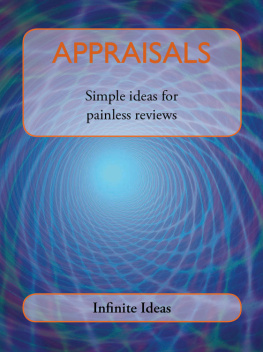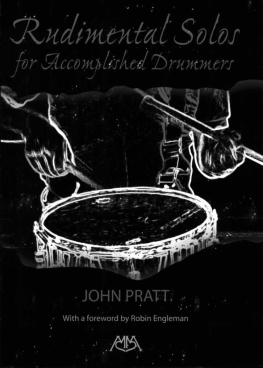Shannon P. Pratt - Analyzing Complex Appraisals for Business Professionals
Here you can read online Shannon P. Pratt - Analyzing Complex Appraisals for Business Professionals full text of the book (entire story) in english for free. Download pdf and epub, get meaning, cover and reviews about this ebook. year: 2016, publisher: McGraw-Hill Education, genre: Romance novel. Description of the work, (preface) as well as reviews are available. Best literature library LitArk.com created for fans of good reading and offers a wide selection of genres:
Romance novel
Science fiction
Adventure
Detective
Science
History
Home and family
Prose
Art
Politics
Computer
Non-fiction
Religion
Business
Children
Humor
Choose a favorite category and find really read worthwhile books. Enjoy immersion in the world of imagination, feel the emotions of the characters or learn something new for yourself, make an fascinating discovery.

- Book:Analyzing Complex Appraisals for Business Professionals
- Author:
- Publisher:McGraw-Hill Education
- Genre:
- Year:2016
- Rating:4 / 5
- Favourites:Add to favourites
- Your mark:
- 80
- 1
- 2
- 3
- 4
- 5
Analyzing Complex Appraisals for Business Professionals: summary, description and annotation
We offer to read an annotation, description, summary or preface (depends on what the author of the book "Analyzing Complex Appraisals for Business Professionals" wrote himself). If you haven't found the necessary information about the book — write in the comments, we will try to find it.
Analyzing Complex Appraisals for Business Professionals — read online for free the complete book (whole text) full work
Below is the text of the book, divided by pages. System saving the place of the last page read, allows you to conveniently read the book "Analyzing Complex Appraisals for Business Professionals" online for free, without having to search again every time where you left off. Put a bookmark, and you can go to the page where you finished reading at any time.
Font size:
Interval:
Bookmark:

Copyright 2016 by McGraw-Hill Education. All rights reserved. Except as permitted under the United States Copyright Act of 1976, no part of this publication may be reproduced or distributed in any form or by any means, or stored in a data base or retrieval system, without the prior written permission of the publisher.
ISBN: 978-0-07-181294-8
MHID: 0-07-181294-6
The material in this eBook also appears in the print version of this title: ISBN: 978-0-07-181293-1, MHID: 0-07-181293-8.
eBook conversion by codeMantra
Version 1.0
All trademarks are trademarks of their respective owners. Rather than put a trademark symbol after every occurrence of a trademarked name, we use names in an editorial fashion only, and to the benefit of the trademark owner, with no intention of infringement of the trademark. Where such designations appear in this book, they have been printed with initial caps.
McGraw-Hill Education eBooks are available at special quantity discounts to use as premiums and sales promotions or for use in corporate training programs. To contact a representative, please visit the Contact Us page at www.mhprofessional.com.
This publication is designed to provide accurate and authoritative information in regard to the subject matter covered. It is sold with the understanding that neither the author nor the publisher is engaged in rendering legal, accounting, securities trading, or other professional services. If legal advice or other expert assistance is required, the services of a competent professional person should be sought.
From a Declaration of Principles Jointly Adopted by a Committee of the American Bar Association and a Committee of Publishers and Associations
TERMS OF USE
This is a copyrighted work and McGraw-Hill Education and its licensors reserve all rights in and to the work. Use of this work is subject to these terms. Except as permitted under the Copyright Act of 1976 and the right to store and retrieve one copy of the work, you may not decompile, disassemble, reverse engineer, reproduce, modify, create derivative works based upon, transmit, distribute, disseminate, sell, publish or sublicense the work or any part of it without McGraw-Hill Educations prior consent. You may use the work for your own noncommercial and personal use; any other use of the work is strictly prohibited. Your right to use the work may be terminated if you fail to comply with these terms.
THE WORK IS PROVIDED AS IS. McGRAW-HILL EDUCATION AND ITS LICENSORS MAKE NO GUARANTEES OR WARRANTIES AS TO THE ACCURACY, ADEQUACY OR COMPLETENESS OF OR RESULTS TO BE OBTAINED FROM USING THE WORK, INCLUDING ANY INFORMATION THAT CAN BE ACCESSED THROUGH THE WORK VIA HYPERLINK OR OTHERWISE, AND EXPRESSLY DISCLAIM ANY WARRANTY, EXPRESS OR IMPLIED, INCLUDING BUT NOT LIMITED TO IMPLIED WARRANTIES OF MERCHANTABILITY OR FITNESS FOR A PARTICULAR PURPOSE. McGraw-Hill Education and its licensors do not warrant or guarantee that the functions contained in the work will meet your requirements or that its operation will be uninterrupted or error free. Neither McGraw-Hill Education nor its licensors shall be liable to you or anyone else for any inaccuracy, error or omission, regardless of cause, in the work or for any damages resulting therefrom. McGraw-Hill Education has no responsibility for the content of any information accessed through the work. Under no circumstances shall McGraw-Hill Education and/or its licensors be liable for any indirect, incidental, special, punitive, consequential or similar damages that result from the use of or inability to use the work, even if any of them has been advised of the possibility of such damages. This limitation of liability shall apply to any claim or cause whatsoever whether such claim or cause arises in contract, tort or otherwise.
T his book was written to combine many appraisal subjects into one text that could help business professionals better understand how to read and review them. It occurred to Dr. Pratt and me that, to our knowledge, nothing like this book was available, and this was the beginning of our collaboration to write it. The challenge was to determine how much information should be includedif there was too much, then readers might get bogged down and not be able to quickly find the information they were seeking. If it did not include enough, then readers might lack the knowledge necessary to determine the credibility of appraisals that they might encounter in their work as bankers, lawyers, accountants, real estate brokers, and other professionals.
Our hope is that we found the correct middle ground, and those who need more information can consult texts that treat the specific appraisal subject they are reviewing with more depth, and those who need less will be pleased that they can find what they need with a minimal effort because there is not an overload of material. All in all, we hope this book fills a need for those who deal with appraisals in the course of their daily business.
John Lifflander, July 2016
T he basis of most appraisal theory is the concept of substitution. People use this theory in everyday life to some extent, as they are confronted with choices in purchasing various items. In its most basic distillation, they compare the same product or similar products that are offered at different prices. The question that often arises is this one: Can a less expensive product be substituted for a more costly one without a loss in quality?
A generic medicine may be cheaper than its brand-name competitor, but is the substitute for the name brand just as effective, safe, and reliable? Given the choice of various automobiles with similar characteristics, a buyer might wonder if it is worth saving money by buying a less popular brand. Will the cheaper car be as reliable and have the same resale value? Is it worth the risk of buying it to save several thousand dollars? Perhaps without realizing it, people use appraisal principles in their lives on a regular basis.
The appraiser is generally not the buyer, so he or she uses the substitution principle from the perspective of a professional analyst. This means appraisers should not impose their own likes and dislikes and other biases about the property under valuation. Rather, they should, to some extent, put themselves in the position of a buyer, as they seek to determine the value of the subject property. For instance, an appraiser might never even think of buying a house next to the freeway because of the constant noise. Nevertheless, to determine the value of the property, the appraiser must consider other sales with a similarly noisy environment and base the value conclusion on what those properties have sold for. Essentially, the appraiser must play the part of a buyer who doesnt mind the noise and who would be shopping for similar properties.
Likewise, an industrial appraiser may think that a particular paper mill is not a good investment because of various economic factors that suggest that demand for the type of paper that the mill produces is waning and, to add to the difficulty, there is more production coming online in the future. For this reason the appraiser, if acting as a buyer, would never consider purchasing the mill. Nevertheless, that personal view should not influence the appraisers value conclusion. The conclusion should include the knowledge of the industry and consideration of the economic issues for the mill that that appraiser has, but the estimate of value should not be influenced by the appraisers subjectivity.
Font size:
Interval:
Bookmark:
Similar books «Analyzing Complex Appraisals for Business Professionals»
Look at similar books to Analyzing Complex Appraisals for Business Professionals. We have selected literature similar in name and meaning in the hope of providing readers with more options to find new, interesting, not yet read works.
Discussion, reviews of the book Analyzing Complex Appraisals for Business Professionals and just readers' own opinions. Leave your comments, write what you think about the work, its meaning or the main characters. Specify what exactly you liked and what you didn't like, and why you think so.








